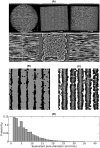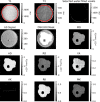Design and characterization of a 3D-printed axon-mimetic phantom for diffusion MRI
- PMID: 34196049
- PMCID: PMC8596689
- DOI: 10.1002/mrm.28886
Design and characterization of a 3D-printed axon-mimetic phantom for diffusion MRI
Abstract
Purpose: To introduce and characterize inexpensive and easily produced 3D-printed axon-mimetic diffusion MRI phantoms in terms of pore geometry and diffusion kurtosis imaging metrics.
Methods: Phantoms were 3D-printed with a composite printing material that, after the dissolution of the polyvinyl alcohol, exhibits microscopic fibrous pores. Confocal microscopy and synchrotron phase-contrast micro-CT imaging were performed to visualize and assess the pore sizes. Diffusion MRI scans of four identical phantoms and phantoms with varying print parameters in water were performed at 9.4 T. Diffusion kurtosis imaging was fit to both data sets and used to assess the reproducibility between phantoms and effects of print parameters on diffusion kurtosis imaging metrics. Identical scans were performed 25 and 76 days later, to test their stability.
Results: Segmentation of pores in three microscopy images yielded a mean, median, and SD of equivalent pore diameters of 7.57 μm, 3.51 μm, and 12.13 μm, respectively. Phantoms had T1 /T2 = 2 seconds/180 ms, and those with identical parameters showed a low coefficient of variation (~10%) in mean diffusivity (1.38 × 10-3 mm2 /s) and kurtosis (0.52) metrics and radial diffusivity (1.01 × 10-3 mm2 /s) and kurtosis (1.13) metrics. Printing temperature and speed had a small effect on diffusion kurtosis imaging metrics (< 16%), whereas infill density had a larger and more variable effect (> 16%). The stability analysis showed small changes over 2.5 months (< 7%).
Conclusion: Three-dimension-printed axon-mimetic phantoms can mimic the fibrous structure of axon bundles on a microscopic scale, serving as complex, anisotropic diffusion MRI phantoms.
Keywords: diffusion MRI; modeling and analysis; validation.
© 2021 The Authors. Magnetic Resonance in Medicine published by Wiley Periodicals LLC on behalf of International Society for Magnetic Resonance in Medicine.
Figures








References
-
- Keenan KE, Ainslie M, Barker AJ, et al. Quantitative magnetic resonance imaging phantoms: a review and the need for a system phantom. Magn Reson Med. 2018;79:48‐61. - PubMed
-
- Beltrachini L, Taylor ZA, Frangi AF. A parametric finite element solution of the generalised Bloch‐Torrey equation for arbitrary domains. J Magn Reson. 2015;259:126‐134. - PubMed
-
- Grebenkov DS. Exploring diffusion across permeable barriers at high gradients. II. Localization regime. J Magn Reson. 2014;248:164‐176. - PubMed
Publication types
MeSH terms
Grants and funding
LinkOut - more resources
Full Text Sources

